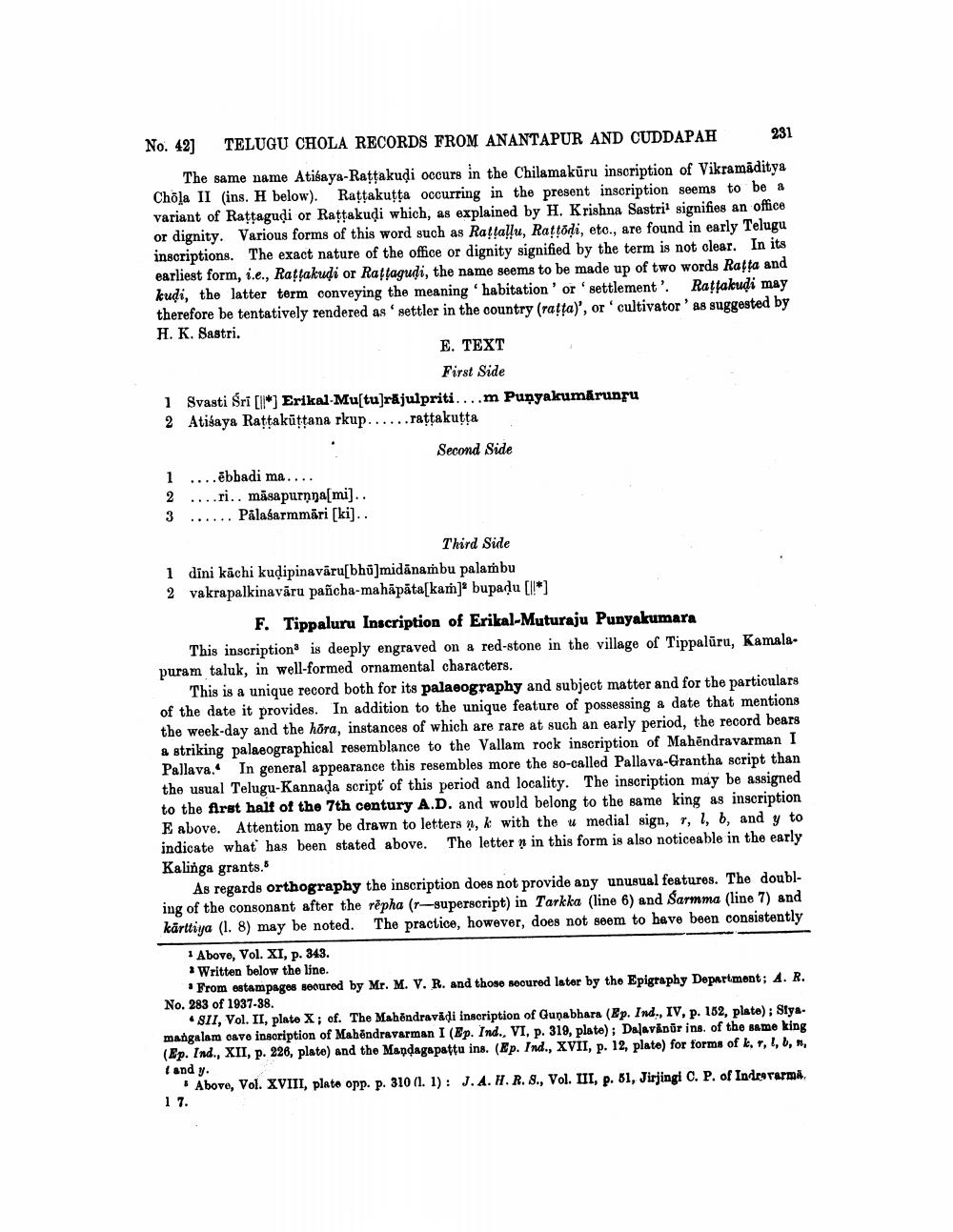________________
No. 42)
TELUGU CHOLA RECORDS FROM ANANTAPUR AND CUDDAPAH
231
The same name Atibaya-Rattakudi occurs in the Chilamakūru inscription of Vikramaditya Chola II (ins. H below). Rattakuțța occurring in the present inscription seems to be a variant of Rattagudi or Rattakudi which, as explained by H. Krishna Sastril signifies an office or dignity. Various forms of this word such as Rattallu, Raffodi, etc., are found in early Telugu inscriptions. The exact nature of the office or dignity signified by the term is not clear. In its earliest form, i.e., Rattakudi or Raftagudi, the name seems to be made up of two words Ratta and kudi, the latter term conveying the meaning 'habitation' or 'settlement'. Rațfakudi may therefore be tentatively rendered as settler in the country (ratta)', or cultivator' as suggested by H. K. Sastri.
E. TEXT
First Side 1 Svasti Sri [l*) Erikal-Mu(tu]rājulpriti. ...m Punyakumărunsu 2 Atisaya Rattaküttana rkup...... rattakutta
Second Side 1 .... ebbadi ma.... 2 ....ri.. māsapurnya[mi].. 3 ...... Palasarmmāri [ki]..
Third Side 1 dini kächi kudipinavāru[bhū]midānambu palambu 2 vakrapalkinavāru pancha-mahāpāta[kam) bupadu [1]*]
F. Tippaluru Inscription of Erikal-Muturaju Punyakumara This inscription is deeply engraved on a red-stone in the village of Tippalūru, Kamalapuram taluk, in well-formed ornamental characters.
This is a unique record both for its palaeography and subject matter and for the particulars of the date it provides. In addition to the unique feature of possessing a date that mentions the week-day and the höra, instances of which are rare at such an early period, the record bears a striking palaeographical resemblance to the Vallam rock inscription of Mahēndravarman I Pallava. In general appearance this resembles more the so-called Pallava-Grantha script than the usual Telugu-Kannada script of this period and locality. The inscription may be assigned to the first half of the 7th century A.D. and would belong to the same king as inscription E above. Attention may be drawn to letters , k with the u medial sign, 1, 1, b, and y to indicate what has been stated above. The letter in this form is also noticeable in the early Kalinga grants.
As regards orthography the inscription does not provide any unusual features. The doubling of the consonant after the rêpha (r-superscript) in Tarkka (line 6) and Sarmma (line 7) and kārttiya (1. 8) may be noted. The practice, however, does not seem to heve been consistently
1 Above, Vol. XI, p. 343. * Written below the line.
. From estampages secured by Mr. M. V. R. and those secured later by the Epigraphy Department; A. R. No. 283 of 1937-38.
.SII, Vol. II, plato X; of. The Mahondravādi inscription of Gunabhara (Bp. Ind., IV, p. 152, plate); Siyamangalam cave inscription of Mahendravarman I (Ep. Ind.. VI, p. 319, plato); Dalavinurins of the same king (Ep. Ind., XII, p. 226, plate) and the Mandagapattu ins. (Ep. Ind., XVII, p. 12, plate) for forms of k, 1, 1, 0, , I and y.
Above, Vol. XVIII, plato opp. p. 310 (1.1): J.A. H. R. 8., Vol. III, p. 81, Jirjingi C. P. of Indrararma. 1 7.




